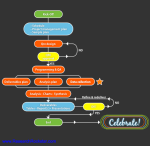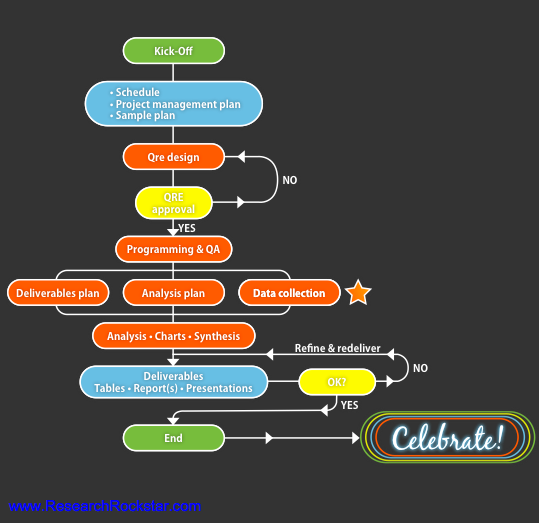If you need to set expectations with colleagues about the quantitative market research process, here you go (see bottom of post): the key steps layed out in a simple flowchart.
I have used this diagram to walk market research newbies through the process many times, and it always gets rave reviews. While the chart is pretty self-explanatory, a few items are worth pointing out:
- Two major steps (questionnaire design and deliverables) are iterative. I always point out that for both of these steps, you need to plan for at least 2 and usually 3 rounds leading to final, approved versions. Inevitably, this leads to a discussion about roles and responsibilities—which is great.
buy sildalis online youmeandtrends.com/wp-includes/sitemaps/providers/php/sildalis.html
- I always stress that during the data collection process, we need to take time to document an agreed upon analysis plan and deliverables plan. Since I am often using this with folks new to market research, this leads to an important discussion about options, which is great to have well before a project starts. Occasionally I get push back on the concept of a “deliverables plan.
buy ventolin online youmeandtrends.com/wp-includes/sitemaps/providers/php/ventolin.html
” But given all the ways of delivering data these days, and the unique needs of different audiences, having a plan documented is great way to avoid last-minute panic.
- And yes, I really do talk about celebrating. Maybe that sounds trite, but with folks new to research, adding a little fun to the process scores some points. And let’s be honest; at the end of a big quant project, a little celebration is in order!
Please feel free to use this chart. If you want me to email you a separate image, just send me a message (KKorostoff@ResearchRockstar.com).
[If you like the blog posts here, you will love the newsletter! Not yet subscribed to the Research Rockstar newsletter?
Sign-up here: SIGNUP]











5 comments
This is great; thanks so much for sharing it! We include something like this is in our proposals, along with a detailed time line for each milestone, and it does help control expectations, This is much prettier though!
Thanks for the feedback Leonard!
Robert: great points! I actually have chapters in my book about both topics! http://www.amazon.com/Hire-Manage-Market-Research-Agencies/dp/0615271146/ref=sr_1_1?ie=UTF8&s=books&qid=1264709830&sr=8-1
This is very good.
The only things I might add are (1) something at the beginning re stating or clarifying research objectives and (2) something re reviewing past or relevant data, such as syndicated data, public data or client data that might be informative to the project .
#1: We’ve all experienced mission creep on projects and this is why I ask the folks in my office to place the research objectives on the front page of the survey draft. This seems to help keep client factions focused on the core tasks.
#2: Unless the research is in a completely new space, it always seems that we can find at least some other data to inform our work. When syndicated or public data is informative, I typically footnote it in the survey.
I’m sure most researchers do both of these. It might be good to capture them in the flowchart.
Thanks again for this.
RPM
In thinking more about this, I’d add one other element at the end – socializing results.
The longer I work in this field, the more I am convinced that the industry has less clout than it should because we don’t do a solid job of pushing the results/implications out through the client organization.
We deliver a solid report with key findings and implications, but the presentation is soon forgotten and the data book sits on the shelf. This is due, in part, because we tend to operate on a project-by-project basis and not on retainer or in some other consultative relationship.
How do we socialize the client organization with the results of the research?
Some answers might include:
1. More high impact charts and graphs, especially what I call “concept charts” that highlight the insights in a broader way.
2. Hone our findings into memorable soundbites.
3. Rebrand the “presentation” as a “strategic working group”
4. Develop “keeper” deliverables that clients want to display in their offices.
I’m sure there are many others.
I also think we need to add “strategic recommendation” to this flowchart. Too often as an industry we are seen as tactical and not strategic. Worse, sometimes we are seen as simply the data dumpers. We need to stretch insight toward foresight and strategy.
RPM
Thanks for the thoughtful comments, Robert. I could not agree more. Another thing I always advise clients to do is to have a visible, active executive endorser. Someone who can set an example of how to use the research. Someone who can create a positive sense of urgency by talking about it at staff meetings, etc.